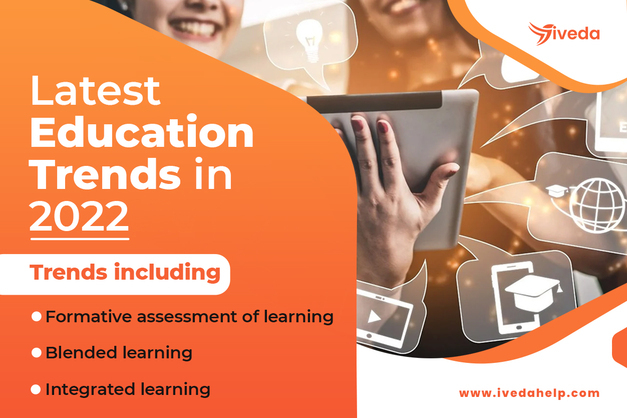Latest Education Trends in 2022
Latest Education Trends in 2022
Change is an inevitable requisite for pushing limits and achieving greatness. If you look up, you will find an array of ever-changing trends and novelties in the evolutionary history of almost every other field. The education sector is no different! From the era of writing on leaves to the present modern age of smart classes, education has taken quite a leap I must say! Education is founded by educational institutions and is molded on their academic grounds. Everything from teaching methods to student engagement is a pivotal factor for affecting the quality of education.
Throughout the years we have seen tons of changes in the education system some of which stayed while the others either were dropped or remodeled.
In 2022, we are glad to have some of the education trends around, that stayed with certain alterations:
Technological upgrading of educators
Formative assessment of learning
Personalized learning
Blended learning
Integrative learning
Let’s delve into each one by one, shall we!
1. Technological upgrading of educators
There is no doubt that educators are an integral part of the education system. The year 2022 is all about establishing another era of technological advancements. The education sector too demands a more technological approach which can be only implied when the educators are well versed with it.
Hence, as per the demands of the latest trend, teachers and trainers are undergoing a schooling phase of their own where their hands-on training is based on a learning management system through media and e-learning supportive tools.
The idea is to make them adapted to the technological skills and new teaching methodologies that are capable enough to keep the attention of the current generation.
2. Formative assessment of learning
Probably the most significant of all, formative assessment of learning is an innovative approach to educating young minds. The old-school method of performance assessment through annual written tests is no longer a viable one. Test scores are quantitative whereas formative assessment is qualitative.
It is a set of personalized procedures conducted by teachers to assess their student’s learning skills that benefit them both. The students are asked to identify the context of a certain topic either by drawing a concept map, creating a poster, submitting 3-way summaries, turning in a research thesis, group discussions, and other means.
It usually involves feedbacks rather than test scores that help the teacher to understand the level of understanding of students.
It helps students to identify their weaknesses and strengths which in turn enable teachers to address their problem areas to work on. Learning achieved via this way is far more effective and strengthens the social competency of a student.
3. Personalized learning
Generally, students tend to perform well on home assignments but not so on class tests. Negating any possibility of cheating, I would propose that they do well from home because there are no time constraints or limitations in personalized learning.
Personalized learning is a cumulative set of flexible educational programs and linear tutelage methods that are optimized to fulfill the needs of a diverse range of students, especially passive and slow learners. Individual learning activities, active project participation, flipped learning with digital lectures, and physical classroom activities, are some of the strategies that implement personalized learning.
This has shown remarkable improvements in student learning abilities rendering them to become more academically active.
4. Blended learning
During the 2022 coronavirus pandemic situation, the principle and applications of blended learning remain the same, only the level of emphasis has changed.
Blended learning is an amalgamation of online and offline learning that rightfully keeps in touch with traditional classroom teaching. Some of the widely used blending learning types are: Enriched virtual, flex blended learning, self-directed, remote blended learning, etc. In each type, the main focus is uniformly attributed to online and offline learning.
Often categorized together with personalized learning, blended learning comprises more contextual factors that are cost-efficient, infrastructure-independent, and pandemic-proof.
5. Integrative learning
Integrative learning is more concerned with enhancing a set of skills such as leadership qualities, critical thinking, problem-solving, and creativity that allows students to handle real-world issues.
Teachers are taking a more skill-oriented teaching approach through integrative learning that includes diverse training activities, learning modes, co-curricular and academic learning experiences.
Integrative learning promotes STEAM education, an acronym for Science, Technology, Engineering, Art, and Mathematics. The STEAM learning approach has picked up quite a pace in the last few years as most professional fields seem to prioritize creativity over conjecture.
To summarise it all
To be honest, the education sector has undergone numerous changes in the last few decades and new trends keep on coming. It is imperative to keep the most idealistic ones and rather than adopting new methods, we should focus on improving the fundamental learning methods aimed at students’ overall development.

